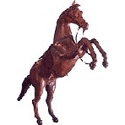Etikoppaka – a small, dusty village with a population of 12,000 in the Vishakhapatnam district is known for its wooden laccoloured objects. Practiced from many generations, this craft historically documented since the 1830s can be taken back to the time of the Bahmani sultanate. Etikoppaka craft has persisted and survived great hardships and its journey till today speaks volumes about the resilience of this craft form.
In the post-independence period, shrinking local demand and low prices resulted in the migration of artisans to urban areas in search of mere jobs. It is even said that out of a total 225 weaving families, there was a time when only one old artisan and his wife were left in Etikoppaka. Post 1990, the introduction of synthetic dyes led to the initial distortion of traditional practices considered essential for the craft. The use of natural dye extracted from the now extinct local tree called Divi-Divi (Caesalpiniacoriaria) for tones of red, formed an important part in the production process.
In the early years of the 20th century in the midst of hardships and the inevitable extinction of this craft, one man saw immense potential and took up the challenge of reviving Etikoppaka. C V Raju – the head of the local landowning family took a keen interest in the local craft of lathe turned and lacquered wood. His efforts to revive the eco-friendly wood-lacquer process with a focus on natural dyes and efficient processes has brought the artisans back to life who are said to have shifted back to their original craft based occupation.
Approximately 200 artisans belonging to VishwaBrahmin, Devanga, Gouda, Padmasali, Konda, Settybaliga and Kapu castes practice this craft. Lac and AnkudiKarra (Wrightiatinctoria) or Ankudu wood form the main raw materials used in the Tharini or the turned wood lacquer process. Ankudu wood comes from a soft tree also known as soft ivory-wood grown abundantly in the local forests. Branches and trunks of the tree are used to create different objects.
The application of Lac was introduced by C V Raja. Lac is a resinous substance used to impart colour to the wood. There are two types of lac known as Rangeen and Kusumi, where the latter is considered to be of superior quality. The tools used are basic and consist of a planer, saw, cutting tools and hand drills. The wood is seasoned and cut to suitable length. The lac sticks are used to lacquer the items. The lac is further oxidized with natural vegetable colour and then applied to the carved wood piece turning on a lathe.Mogalireku (kevda leaf) is used for finishing and flair to the product. Lacquer work is an extensive process and can be performed either by lathe, machine or hand. Revival of the craft was again led to the identification and use of various natural and vegetable dyes with available colours ranging from previously available tone red to ochre, olive, turquoise and indigo blue.
Etikoppaka originally consisted of wooden articles made for domestic and religious use. Moreover, toys, mythological figures and carvings are said to be exquisite belonging to the Etikoppaka craft. To tap the market potential, various home décor and decorative items like ornaments, cups, lamps, bangles, jewellery boxes, photo frames, cutlery, table ware, and oil bottles form some of the recent and popular products. These products have also found a good market overseas.
Efficient technology and application of traditional methods have resulted in steady improvement of the Etikoppaka craft. However, to say that the problems surrounding the Etikoppaka artisans have diminished would be fallacious. Stringent export norms, eroded markets with cheaper non-original copies of Etikoppaka are some of the issues which require attention. Moreover, inadequate supply of wood threatens to weaken the stability of the artisans. The forest department imposes a fine on the artisans if wood is obtained directly and thus, the artisans remain dependent on middlemen and vendors. Awareness of the craft has led to various institutions of fine art of Andhra Pradesh, NID, and NIFT to get involved in the designing and further development of Etikoppaka craft. Moreover, various societies such as Padmavati Associates, EtikoppakaVanaSamrakshanaSamiti (Forest protection committee) continue to work towards preserving and conserving the existing and future wood stock required for Etikopakka.



